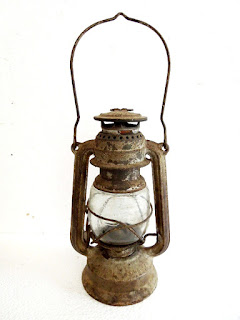Hurricane lamp
Hurricane lanterns are known the World over for its versatility, mobility and reliablity, as the name signifies they withstand burning even amidst a hurricane. They are made from zinc-plated material which protects against corrosion. The special engineered burner operates with no flickering, or soot from the flame. These lanterns also feature a heat resistant Fire proof RGW globe that can withstand operation in the rain or snow, without cracking.
The lamp burner has a flat wick, usually made of cotton. The lower part of the wick dips into the fountain and absorbs the kerosene by capillary action; the top part of the wick extends out of the wick tube of the lamp burner, which includes a wick-adjustment mechanism. Adjusting how much of the wick extends above the wick tube controls the flame. The wick tube surrounds the wick, and ensures that the correct amount of air reaches the lamp burner. Adjustment is usually done by means of a small knob operating, which a toothed, metal sprocket is bearing against the wick. If the wick is too high, and extends beyond the burner cone at the top of the wick tube, the lamp will produce smoke and soot (un burned carbon). When the lamp is lit, the kerosene in the wick burns to produces a clear, bright, yellow flame. As the kerosene burns, capillary action in the wick draws more kerosene up from the fuel tank. All kerosene flat wick lamps use the dead flame burner design, where the flame is fed cold air from below and hot air exits above. The principle behind this lantern is cold air being circulated and fed through the tubes at the sides to the wick end thereby providing constant oxygen supply keeping the flame burning bright at the same time withstanding fierce wind flow. Flat wick lanterns burn brightest with kerosene fuel for which they are made for, but also work fine on clear lamp oil, Petrol and turpentine. The once important part of life now rests at connoisseurs homes as works of art...
The lamp burner has a flat wick, usually made of cotton. The lower part of the wick dips into the fountain and absorbs the kerosene by capillary action; the top part of the wick extends out of the wick tube of the lamp burner, which includes a wick-adjustment mechanism. Adjusting how much of the wick extends above the wick tube controls the flame. The wick tube surrounds the wick, and ensures that the correct amount of air reaches the lamp burner. Adjustment is usually done by means of a small knob operating, which a toothed, metal sprocket is bearing against the wick. If the wick is too high, and extends beyond the burner cone at the top of the wick tube, the lamp will produce smoke and soot (un burned carbon). When the lamp is lit, the kerosene in the wick burns to produces a clear, bright, yellow flame. As the kerosene burns, capillary action in the wick draws more kerosene up from the fuel tank. All kerosene flat wick lamps use the dead flame burner design, where the flame is fed cold air from below and hot air exits above. The principle behind this lantern is cold air being circulated and fed through the tubes at the sides to the wick end thereby providing constant oxygen supply keeping the flame burning bright at the same time withstanding fierce wind flow. Flat wick lanterns burn brightest with kerosene fuel for which they are made for, but also work fine on clear lamp oil, Petrol and turpentine. The once important part of life now rests at connoisseurs homes as works of art...
Authored by
Sridhar, MBA, MTM, MHRM.,
Founder - Indian Antique Quest
Antique Curio Etailer
Find us on:
facebook.com/pg/indiantiquest/shop
pinterest.com/indiantiquest/
instagram.com/indiantiquest/
pinterest.com/indiantiquest/
instagram.com/indiantiquest/
Write to us - indiantiquest@gmail.com










Amazing quality content on lantern. I have been regularly writing on
ReplyDeletethe best hurricane lantern for home use